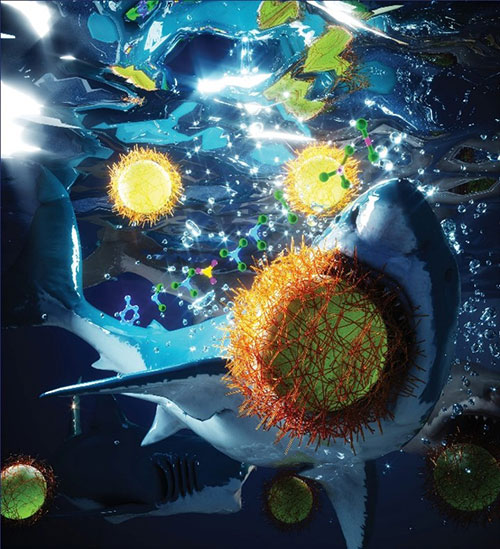Molecular Brushes Stabilize Nanoparticles in Extreme Solution Environments
January 31, 2023
 enlarge
enlarge
A thin, dense layer of designed peptoid molecules (red coating) stabilizes metal nanoparticles (spheres) in different solutions. The destabilizing factors, represented by sharks, include high salt environments and organic solvents
Scientific Achievement
CFN researchers and collaborators developed a series of molecular brushes that both functionalizes inorganic nanoparticles (gold, silver, platinum, and iron oxide) and stabilizes them in a diverse spectrum of solution environments.
Significance and Impact
Engineering nanoparticle interfaces using peptoid sequences and molecular architectures can provide multifunctionality and facilitate their compatibility with biomedical and green industrial processes.
Research Details
Controlling the interfaces and interactions of nanoparticles via tethered molecular moieties is crucial for their applications in electronics, optics, catalysis, and nanomedicine. The research team led by Oleg Gang from the Center for Functional Nanomaterials (CFN) at Brookhaven Lab (BNL) developed a new general and robust approach for engineering the nanoparticle interfaces with molecular coatings, while maintaining a thin molecular shell (~1.5 nm) at the surface.
The researchers designed a series of low-molecular-weight, bifunctional comb-shaped, and sequence-defined peptoids and used them to stabilize different types of particles, including gold, silver, platinum, and iron oxide nanoparticles. Each peptoid has different arrangements of a multivalent nanoparticle-binding motif and a solvation motif. Among designed peptoid architectures, the type of a diblock structure formed a thin molecular layer on nanoparticle surfaces for superior stability in diverse environments.
The team also used molecular dynamics simulations to study the role of interactions between peptoid molecules, nanoparticle surfaces, and solvent molecules in the nanoparticle stabilities, and rationalized the structural characteristics of the diblock peptoid monolayer coating and mechanisms of interactions responsible for the experimental observations.
Besides the superior stability, the peptoid coatings play a significant role in promoting the properties and functionalities of the coated nanoparticles. The peptoid-coated nanoparticles are resistant to biofouling and can phase transfer from aqueous to organic solvents. In addition, the researchers showed self-assembly of peptoid-coated nanoparticles into two-dimensional nanoparticle superlattices at the vapor-aqueous interfaces, as probed by synchrotron x-ray scattering from liquid surfaces at NSLS-II.
The work demonstrates that peptoid design allows for control over the sequence and architecture, which can enrich nanomaterial functionalities through the engineering of nanoparticle surface coatings. This class of peptoids can be further diversified using the large chemical library of solid-phase synthesis. The development of peptoid coatings in this work provide molecular-level control over nanoparticle interfaces, which will facilitate their applications in materials science, nanotechnology, and nanomedicine.
- The thin peptoid shell coatings (~1.5 nm) stabilize the nanoparticles in solutions with high salt concentrations, across a wide pH range, and through freeze/thaw treatments.
- Stabilized nanoparticles are resistant to biofouling, resilient to aqueous-to-organic phase transfer, and can be made to assemble into 2D lattices.
- The CFN Materials Synthesis & Characterization Facility, Molecular Foundry, and NSLS-II were used for this study.
BES Capabilities
The CFN Materials Synthesis & Characterization Facility, the Molecular Foundry (peptoid synthesis support), and the NSLS-II Open Platform Liquid Scattering (OPLS) end station were used in this study.
Publication Reference
Wang, S.-T.; Zhang, H.; Xuan, S.; Nykypanchuk, D.; Zhang, Y.; Freychet, G.; Ocko, B. M.; Zuckermann, R. N.; Todorova, N.; Gang, O. “Compact Peptoid Molecular Brushes for Nanoparticle Stabilization.” Journal of the American Chemical Society 144, 8138 (2022).
DOI: https://doi.org/10.1021/jacs.2c00743
OSTI: Compact Peptoid Molecular Brushes for Nanoparticle Stabilization (Journal Article)
Journal Cover: Journal of the American Chemical Society | Vol 144, No 18 (acs.org); Wang, S.-T. et al. J. Am. Chem. Soc.144, 7951 (2022).
Acknowledgment of Support
The authors thank the support from the Center for Functional Nanomaterials (CFN), the Molecular Foundry, the National Synchrotron Light Source II (NSLS-II), the Laboratory Directed Research and Development (LDRD) grant at Brookhaven Lab, and the Office of Science, the Office of Basic Energy Sciences of the U.S. Department of Energy under Contracts No. DE-SC0012704 and No. DE-AC02-05CH11231. The molecular dynamics simulations were undertaken with the assistance of resources and services from the National Computational Infrastructure (NCI, Project e90), which is supported by the Australian Government. This research used the Open Platform Liquid Scattering (OPLS) end station at the National Synchrotron Light Source II, Brookhaven National Laboratory, a U.S. Department of Energy (DOE) Office of Science User Facility operated for the DOE Office of Science by the Brookhaven National Laboratory under contract No. DE-SC0012704. The authors thank Michael Connolly and Natalia Molchanova at the Molecular Foundry for their help on peptoid synthesis.
2023-21214 | INT/EXT | Newsroom









